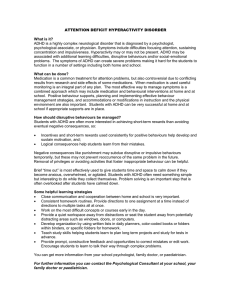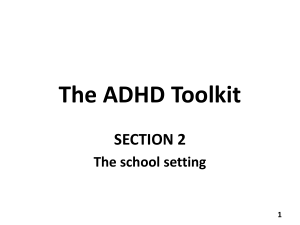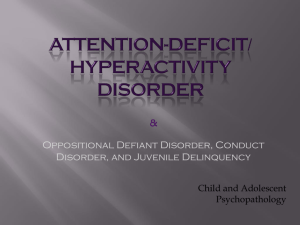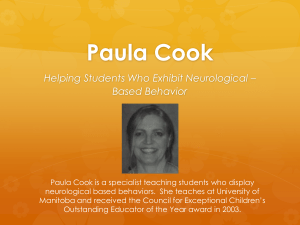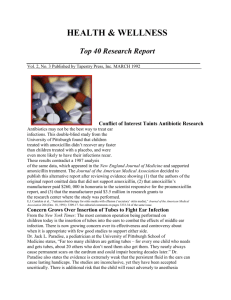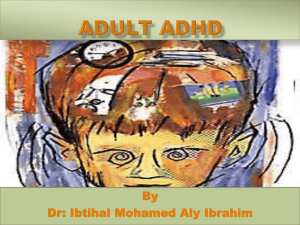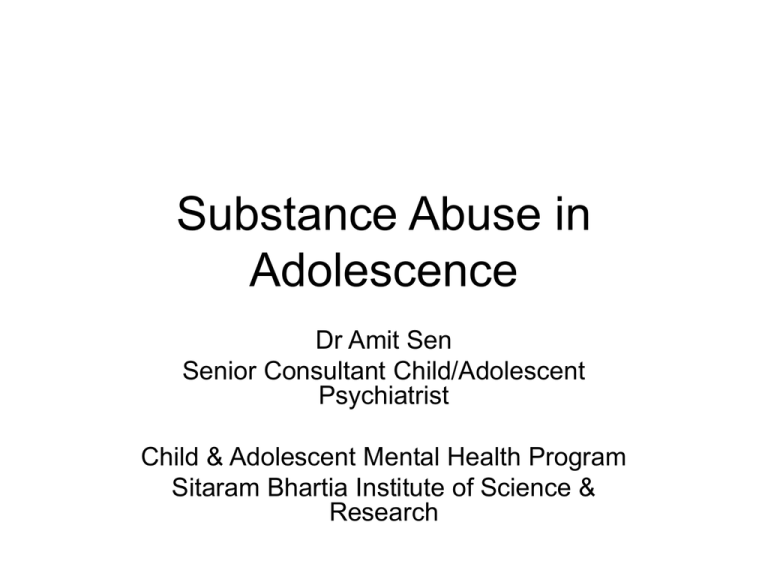
Substance Abuse in
Adolescence
Dr Amit Sen
Senior Consultant Child/Adolescent
Psychiatrist
Child & Adolescent Mental Health Program
Sitaram Bhartia Institute of Science &
Research
Substance Abuse
•
•
•
•
•
Epidemic proportions in
schools
Smoking, alcohol,
cannabis & solvents are
common
Behavioural, emotional,
relationship and
academic problems
Associated mental
health problems
Poor awareness
Why use them?
• Rebellion
• Curiosity/Adventure
• AvailabilityMarketed/Advertised
• Easy pleasure
• Being “cool”
• Peer pressure/Desire to
belong
• Chilled out/Relaxed
• Relief from pain & chaos
• Self medication
• Ape adults/seniors
• Style, glamour
Wide range of warning signs
•
•
•
•
•
•
•
•
•
Unexplained weight loss
Red eyes, nasal irritation
Chronic cough, wheezing
Blank, staring into space
Needle tracks, scratch
marks
Poor short term memory
Truancy, falling grades
Conflict with parents,
teachers, suspension
Acute psychosis/
paranoia
Wide range of warning signs
•
•
•
•
•
•
•
Risk taking behaviours
Mood swings, depression, panic reaction
Lying, stealing, promiscuity
Altered sleep & appetite
Poor hygiene
Withdrawn, lack of interests
Preferences for dress, music, movies
identifying with drug culture
Co-morbidity
•
•
•
•
•
•
•
ADHD(attention deficit hyperactivity disorder)
Conduct Disorders
Depression
Anxiety
PTSD
Self harming behaviours
psychosis
Attention Deficit Hyperactivity
Disorder (ADHD)
ADHD occurs in 3-5% of school age children. ADHD
must begin before the age of seven and it can continue
into adulthood.
ADHD runs in families with about 25% of biological
parents also having this medical condition
Male : Female = 4:1
Impairment in three areas:
– Attention
– Impulsivity
– Hyperactivity
Attention Deficit Hyperactivity
Disorder (ADHD)
•
•
•
•
•
•
•
•
•
•
•
Easily distracted
Makes careless mistakes
Forgetful
Looses things, disorganised
Unfinished work
Trouble in listening
Underachievers
Disruptive, “naughty boys”
Rash, impulsive
“On the go”, fidgety
Noisy/ interrupts
ADHD ……contd
•
•
•
Persistent and Pervasive
Develops from toddler hood
Differential Diagnosis
–
–
–
–
•
Attachment Problems
Anxiety
Conduct Disorder
SLD
Detailed Family and Development Hx
Conduct Disorders
Persistent patterns of behaviours
• Aggressive
–
–
–
•
Dissocial
–
–
–
•
Fighting or bullying
Cruelty to animals/people
Severe tempers
Lying and/or stealing
Fire setting
Destructiveness to property
Defiant
–
–
–
Persistence severe disobedience
Truancy/running away from home
Provocative
Conduct disorders-contd.
Associated Disorders
• ADHD
• Depression/Affective Disorder
• Specific Learning Disability
• Substance misuse
• Attachment problems
The Depressed Adolescent
•
•
•
•
•
•
•
•
•
•
Behavioural problems
– Lying, stealing
– Violent outbursts
– Truanting
– Indiscriminate sexual
behaviour
Drugs & alcohol
Fluctuating moods
Increased irritability, anger, or
hostility
Risk taking behaviours
Interpersonal conflicts
Extreme sensitivity to rejection or
failure
Variety of physical complaints
Poor performance in school
Poor concentration
The Depressed Adolescent
•
•
•
•
•
•
•
•
•
•
Frequent sadness,
tearfulness, crying
Feeling of emptiness
Decreased interest in
activities
Low energy
Socially isolated
Low self esteem and
guilt
Change in eating and/or
sleeping patterns
Talk of or efforts to run
away from home
Thoughts or expressions
of suicide
Psychotic Features
The Anxious Adolescent
•
•
•
•
•
•
•
•
•
•
•
Refusing to go to school
Irritability and anger outbursts
Fear of making mistakes/
“perfectionist”
Seeking reassurance from
peers
Frequent stomach-aches,
other physical complaints
Overly clingy, panic
Trouble sleeping or
nightmares
Phobias, Social anxiety
Sense of doom
Constant worries
Low self esteem
Three main symptoms of PTSD
1. Intrusions- flashbacks & nightmares
2. Avoidance- attempt to reduce exposure
to situations that bring back memories
3. Hyper-arousal- tension, hyper-vigilance
and increased startle response
Effects of Trauma –
Developmental Picture
Pre-adolescence and Adolescence
• Nightmares and flashbacks
• Difficulty sleeping
• Anxiety & Depression
• Feeling detached or estranged
• Impulsive and aggressive behaviours
• Preoccupation with other concerns unrelated to the
trauma
• Rebelliousness
• Risk-taking behaviours (drugs, alcohol, sex)
•
Confusion with identity, roles and responsibilities
Suicide - High Risk Factors
• Acute
embarrassment/loss
• Strong desire to die with
lethal method in mind
• Older youth
• Prior attempts
• Male
• Major psychopathology
• Substance abuse
• High stressors
• Poor communication with
adults/peers
• Poor family support
Warning Signs
• Hopelessness,
helplessness
• Definite mood change
• Withdrawn
• Couldn’t care less attitude
• No planning for future
• High risk taking
behaviours
• Severing of ties
• Completing certain tasks
• Cutting/scratching/drug
abuse
• Writing notes
MANAGEMENT
• PREVENTION
• INTERVENTION
Protective Factors
•
•
•
•
•
•
•
•
•
•
•
Nurturing environment
Good communication
Adult supervision
Positive self-esteem
Assertiveness
Social competence
Good education
Good general health
High intelligence
Adult role models
Religious/sense of morality
Four Rs of Working with
Adolescents
Responsible
Respect
Root Values
Relationship
Keys to Successful Relationship
•
•
•
•
•
Contact
Congruence
Positive Regard/Respect
Empathy
Perception
What is Normal?
•
•
•
•
•
•
•
Rebellion
Defiance
Rudeness/talking back
Mood swings
Risk taking/experimenting
Lying
Crossing limits/breaking rules
What is Acceptable?
•
•
•
•
•
•
•
Rebellion
Defiance
Rudeness/talking back
Mood swings
Risk taking/experimenting
Lying
Crossing limits/breaking rules
Boundaries
Negotiable
Non-Negotiable
Teenage Skills for Carers
•
•
•
•
•
•
•
•
•
•
Genuineness
Level of confidence
Follow her lead
Be comfortable with lingo
Allow time for trust
Highlight their interests and strengths
Acknowledge vulnerability
Stay connected to feelings
Self disclosure
Taboo subjects
Teenage Skills for Carers
First Things First!
• Respect his/her uniqueness
• Build a supportive, caring and mutually
respectful relationship
• Believe in their competencies
Loosen up
but don’t let
go
• Rigid /permissive
• Love & Limits go
together
• Limits for protection
& guidance not
punishment /power
• Give reasons
• Firmness & flexibility
• Negotiate and resolve
conflicts
• Renegotiate
responsibilities
and privileges
• Learn alternative
strategies don’t
be frustrated
with failure
• Be consistent
and firm

